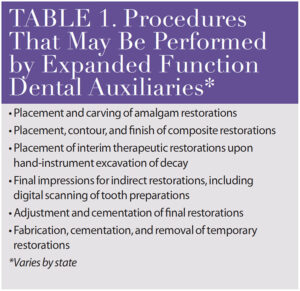 BOJAN89 CREDIT/ISTOCK/GETTY IMAGES PLUS
BOJAN89 CREDIT/ISTOCK/GETTY IMAGES PLUS
Scope of Practice Expansion Opportunities For Dental Hygienists
Current expansion possibilities can help grow the role of dental hygienists in dental practice and communities across the United States.
For many years, dental hygienists were limited to treating and maintaining periodontal conditions and providing patient education. Fortunately, the scope of practice for dental hygienists has been expanding in many areas of the United States. The US government system of classifying occupations—Standard Occupational Classification—recently revised the category of dental hygienist from “Health Technologists and Technicians” to “Healthcare Diagnosis or Treating Practitioners,” which should lead to additional opportunities for this important member of the dental team.1 This article takes a look at some of those avenues currently available in the US.
Expanded Function Dental Auxiliary Certification
Believe it or not, more than 40 job titles exist for clinicians who hold an expanded function dental auxiliary (EFDA). With its inception in the 1970s, EFDA certification enables healthcare professionals to perform various reversible dental procedures under the direct supervision of a dentist. With more than half of states allowing some expanded function duties, educational requirements and permitted procedures for an EFDA vary greatly from state to state.2 In many states, EFDA certification includes the word “assistant” instead of “auxiliary,” which can be misleading. This certification is often available to both dental assistants and dental hygienists. I encourage dental hygienists to investigate what is allowed in their state to determine if there are any additional skills that they can obtain and implement into practice. For example, an EFDA certification in the state of Arizona allows a certified auxiliary to place, carve, and finish amalgam and composite restorations, as well as to place interim therapeutic restorations.
Table 1 lists some or all of the procedures, depending on the state, that may be performed by a clinician with an EFDA certification under the direct supervision of a dentist. These procedures are not allowed under the registered dental hygiene license in most states. However, if dental hygienists fulfill all of the state requirements for an EFDA, they are able to add them to their scope of practice. The addition of these skills only increases the value that dental hygienists bring to the dental team by improving efficiency and production. Additionally, these skills can create variety in dental hygienists’ daily routines.
Most EFDA certifications are 2-month to 6-month programs with both didactic and hands-on classes designed to prepare clinicians for the required written national examinations and the application of newly learned skills in practice. While there is no hands-on board exam requirement, many states mandate a written affidavit of completion of designated number of different procedures under the direct supervision of a dentist in order to qualify for the state license/certificate.
For dental hygienists interested in learning more about expanded functions, here are some recommended steps:
- Check if your state permits expanded function designation, what procedures are allowed under the certification, and the list of requirements for obtaining the certificate by visiting your state’s dental board website or the Dental Assisting National Board website at: danb.org.
- Research Commission on Dental Accreditation-certified expanded function programs in your state. A list of these programs is available at: danb.org.
Dental Therapy Licensure
Dental therapy licensure presents another midlevel practitioner opportunity, and is similar to the nurse practitioner designation. These dental healthcare professionals are trained to perform a number of irreversible procedures that include nonsurgical extractions and preparing teeth for direct restorations, such as composites and amalgams. The creation of dental therapists is based on the need to improve access to dental care for disadvantaged, underserved populations in remote, rural areas of the country. However, the widespread midlevel practitioner model has met great resistance from organized dentistry due to concerns about the provision of substandard care from clinicians who have less training than dentists, and fear of encroachment upon dentists’ scope of practice.3
Just as with the EFDA, dental therapy is authorized by state law. To date, 13 states offer dental therapy authorization statewide, as a pilot project, or on Tribal lands; although, more states are considering its addition.4 To find a comprehensive list of states and their requirements visit: adha.org/resources-docs/Expanding_Access_to_Dental_Therapy.pdf.
The majority of state dental therapy legislation has been passed in the last 3 years, which may indicate that in the next decade, dental therapy will be a widely accepted profession. However, there is a limiting factor: lack of CODA-accredited dental therapy programs in the US. Currently, only the Iḷisaġvik College Alaska Dental Therapy Education Program has received CODA accreditation. This limits the ability of dental therapy to gain wide implementation. For example, the state of Arizona requires that dental therapists must earn a dental therapy degree from a CODA-accredited school, and, as there are no CODA-accredited dental therapy programs in Arizona or nearby states, dental therapy is merely a theoretical profession in Arizona at this time.
Creating an advanced education program and obtaining the necessary CODA accreditation are extensive, expensive, and time-consuming processes. Dental hygienists interested in dental therapy, should thoroughly investigate their state’s legislature to ensure they are able to expand their scope of practice and utilize these new skills.
Community Dental Health Coordinators
Created by the American Dental Association (ADA), community dental health coordinators (CDHC) are community-based healthcare workers with dental skills. They are designed to serve as a missing link between underserved populations and dental healthcare providers. The ADA launched this program in 2006 and has been an active proponent of recruiting and educating more dental auxiliary to promote and improve community oral health.5 Currently, 45 states have CDHC graduates, students, or schools. CDHCs are trained to provide limited clinical services such as screenings, fluoride treatments, sealant placement, coronal polishing, and radiographs. They work with supervising dentists to provide necessary dental care to the underserved. CDHCs can start their own mobile consulting and care business by reaching out to schools, group homes, and assisted living facilities. To learn more about CDHC opportunities, visit: ada.org/en/public-programs/action-for-dental-health/community-dental-health-coordinators
Conclusion
Dental hygiene is an important profession that plays an integral role in providing valuable services to advance oral health. Current expansion possibilities can help grow the role of dental hygienists in dental practice and communities around the US even further. Educate, promote, and motivate!
References
- United States Department of Labor. Standard Occupational Classification. Available at: bls.g/v/soc. Accessed November 11, 2020.
- Dental National Assisting Board Inc. State Requirements. Available at: danb.org. Accessed November 11, 2020.
- American Student Dental Association. Midlevel Providers. Available at: asdanet.org/index/get-involved/advocate/issues-and-legislative-priorities/Midlevel-Providers. Accessed November 11, 2020.
- American Dental Hygienists’ Association. Expanding Access to Dental Care. Available at: adha.org. Accessed November 11, 2020.
- American Dental Association. Action for Dental Health: Community Dental Health Coordinators. Available at: ada.org/en/public-programs/action-for-dental-health/community-dental-health-coordinators. Accessed November 11, 2020.
From Perspectives on the Midlevel Practitioner, a supplement to Dimensions of Dental Hygiene. November 2020(12):24-26.


